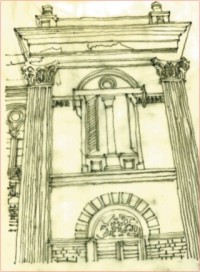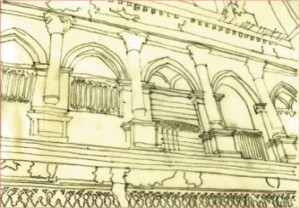Feature
An Architect's Dhaka
Dr. Mahbubur Rahman
Part-8
 Sayeed sir (Abdullah Abu Sayeed) wrote in one of his recent books “Bangali Konodin Raja Chilona (the Bengalis were never kings)”. Of course there were few Bengali Kings. One of the greatest kings from South Asia was Bijaysingha who could be easily compared with Napoleon or Akbar. What Prof. Sayeed meant was Bengalis were less experienced in governance and organizations. We had many kings but few of the palaces (to last). What have survived were not palaces, but rather large kuthis (mansions) of the rulers and nouveaux riches. Sayeed sir (Abdullah Abu Sayeed) wrote in one of his recent books “Bangali Konodin Raja Chilona (the Bengalis were never kings)”. Of course there were few Bengali Kings. One of the greatest kings from South Asia was Bijaysingha who could be easily compared with Napoleon or Akbar. What Prof. Sayeed meant was Bengalis were less experienced in governance and organizations. We had many kings but few of the palaces (to last). What have survived were not palaces, but rather large kuthis (mansions) of the rulers and nouveaux riches.
I have seen Buckingham Palace and Kensington Palace, Versailles Palace and palaces in Brussels, Amsterdam and Dan Haag, palaces in India, Myanmar and Bangkok, palaces in Riyyadh, Kuwait, Abu Dhabi, Dubai, Muscat, Tehran and Ispahan in India, in Stockholm and Lisbon. Some of them have been turned into museum, some were retained as palaces. Some had kings and queens living there, some others were just maintained as it is without being used. The list is seemingly endless.
These palaces dominate their surroundings not by shear size, but by their setting in the context. Some of them indeed could not have been smaller. Some of them stand just on the street. You could wander around without knowing that you were passing by a palace of a once mighty king, which possibly witnessed ups and downs in the history and the fortunes of the king. What made them outstanding were the settings amidst a landscaped garden, often symmetrically laid out with fountains, sculptures, pavilions and mazes, and on an axis. The vista from a distance prepares you physically and mentally, and the sight humbles your approach; their elegance would engulf you as you draw closer.
I have wondered where our palaces were. Ahsan Manjil is really not a palace but a large mansion of a private citizen. Nimtali Palace was actually a kuthi, possibly a pavilion or bungalow type residential building. I however didn't search for an answer as I knew we didn't have any king. But we had Subehdars and Governors, and now we have Presidents, who of course led kingly lives. They must have lived in palatial houses. This didn't bother me much, until I thought okay, then where did Shaista Khan live, or where did Emperor Shajahan (Prince Khurram) stayed when he came to plunder the city, attracted by its wealth?
I could remember a program I saw on BTV long time ago; the presenter was a famous historian. It was 'Dekha Hoy Nai Chokkhu Melia'. And he took us to a ruined palace on the other side of the river in Jinjira, and described the history and the tales around that cursed building. Then last year there was a reporting in a private TV channel where the reporter was showing traces of that palace, occupied by squatters oblivious of its importance. Possibly the Daily Star too ran a story. I knew that it was connected with the Lalbag with a wooden bridge, and also possibly through a tunnel which has been prohibited to enter for long. Interestingly the second bridge across the river was built more than three and half centuries later with Chinese assistance.
Recently my students did a project in the Central Jail site (what to do with the vast land once the Jail is relocated), and visited old Dhaka for the second time in their life; the first time was when I sent them to document some heritage structures around the Bahadur Shah Park. I heard that a group of senior BUET students are doing the same exercise this semester. I tried to locate the Jinjira Palace emphatically in the Google Earth by drawing an axis from south of the old Fort (Jail) through the Chawkbazaar, Bara Katra gate and Swarighat; but failed to locate it. I was hoping to extend the axis up to the Swadhinota Stambha (Independence Monument in Sohrawardi Uddyan), and develop a strong design concept connecting the old and the new. So I decided to go for it on the other side of Buriganga. Meanwhile I started reading on how or where the Subehdars resided.
Most of the Subehdars preferred to stay in ordinary buildings or inside forts. These were those, for example Islam Khan or Mir Jumla, who were during their reign in Dhaka mostly involved in battles, had no time to build a palace for themselves, and found it convenient and functional to live in the fort. The first Subehdar lived in the old Afghani Fort, which later had two gates- in the East and the West. To the South of it was the Badshahi Bazaar (royal market, now known as the Chawkbazaar); it developed spontaneously without a Charter, which in fact came after the Subehdars left and the capital was shifted.
Later a Chehl Satun or Forty-Pillar Pavilion-Palace was erected inside the fort, of which there is now no trace. Some travellers even compared it with Kremlin (size and elegance). This has intrigued me as the beauty of these majestic structures cannot be described to those who haven't seen them. I had a chance to visit Iran couple of years back, and have seen these lofty square buildings in the middle of Persian gardens in Tehran, Ispahan and Shiraz, and how they dominate the entire vista even if watched from hundreds of metres away. The old Fort, along with the nearby Katras, was variously used to house secretariat, treasury and cantonment. Later for sometime after the Mughals left it was let to ruin until the early-19C when a convict gaol and a lunatic asylum and hospital was established within its compounds.
 The greatest ruler of them, who in fact built maximum number of civic and religious buildings in Dhaka and thus gave rise to a style known by his name, was Shaista Khan. Appointed twice (1664-1677, 1680-1688), Shaista Khan was one of the longest serving Subehdar of Bengal too. He was the son of Emperor Shahjahan's Chief Minister Asaf Khan, and brother of Empress Mumtaj Mahal, and thus very powerful too. Shaista Khan, though built a wooden house surrounded by walls inside the Lalbag Fort, yet stayed in a tent in its premises. In fact he was supposed to complete the fort as a palace enclave which his predecessor Shahjada Azam Khan started; but didn't feel like doing so after the demise of his beloved daughter Paaribibi, according to one version buried in the Fort compound in a beautiful mausoleum. Azam Khan was supposed to marry Paaribibi which did not happen, and he was called back to Delhi by his father Emperor Aurangazeb. The greatest ruler of them, who in fact built maximum number of civic and religious buildings in Dhaka and thus gave rise to a style known by his name, was Shaista Khan. Appointed twice (1664-1677, 1680-1688), Shaista Khan was one of the longest serving Subehdar of Bengal too. He was the son of Emperor Shahjahan's Chief Minister Asaf Khan, and brother of Empress Mumtaj Mahal, and thus very powerful too. Shaista Khan, though built a wooden house surrounded by walls inside the Lalbag Fort, yet stayed in a tent in its premises. In fact he was supposed to complete the fort as a palace enclave which his predecessor Shahjada Azam Khan started; but didn't feel like doing so after the demise of his beloved daughter Paaribibi, according to one version buried in the Fort compound in a beautiful mausoleum. Azam Khan was supposed to marry Paaribibi which did not happen, and he was called back to Delhi by his father Emperor Aurangazeb.
We know of several other palaces as well, which of course did not survive. Shahjada Azimusshan built a wooden palace at Posta to the South of the Fort, and used to live there in pomp and fair. From its balcony he saw the departure of powerful Diwan Kartalab Khan (later Nawab Murshid Kuli Khan) with his staff, with him the demise of Dhaka's status and fortunes.
The Subehdar Ibrahim Khan (the second) built his palace in Jinjira on the south of the river. This earned infamy by being used to imprison Amena Begum, Ghaseti Begum, the mother and aunt of Nawab Sirajuddowlah, and some other female family members, by order of Mir Miran, the notorious son of Mir Jafar. It already had Sarafraj Khan's family allowed by Aliwardi Khan to live there. Siraj's relatives were led to tragic death in a staged boat drowning in Dhaleswari by Bakar Khan, the assassin sent by Miran, in the Summer of 1760. Siraj was defeated in the Battle of Palashi in 1757 in a sequel of several treacherous and intrigue events in the struggle for power, money and right to business (exploit of local produces by the East India Company), and eventually murdered. This paved the way for the British to gain the administrative and revenue power over Bengal by 1765.
Jinjira is a corrupt of Arabic 'zajira' meaning island. The grand palace-fort surrounded by a moat was full of buildings. At its north-eastern corner were seven small pich-roofed structures. An octagonal derelict building nearby, and a detached hammamkhana (bathhouse), originally a 2-storied structure, can now be traced. It had chambers covered with domes with apertures, fitted with earthen water pipes embedded in the walls, and used for various functions of the hammam. Similar arrangements as part of an elaborate plumbing system is now being unearthed at the Lalbag Fort too.
Bara Katra was also designed as a residence for Subehdar Shahjada Suja which however he did not or could not use. But it has been used to accommodate Nawabs, Naibs and later high English officers in various periods, though temporarily. With its imposing riverfront façade, the Bara Katra possibly was the most beautiful and imposing building in Dhaka during its time. Chota Katra to its East built a decade later by Shaista Khan was used as government office and residence of high class Mughal court officials. Architectural form of these two quarters is similar to such residences and madrashas built all over Iran and middle-Asia cells around a court much suitable to the particular function and climate.
(Parts of two palatial buildings in old Dhaka, sketch by Mahmudur Rahman Masum, a student of architecture at the North South University)
|
